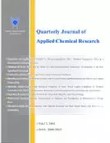فهرست مطالب
Journal of Applied Chemical Research
Volume:16 Issue: 3, Summer 2022
- تاریخ انتشار: 1401/05/20
- تعداد عناوین: 6
-
-
Pages 8-17
In this work, silica nanoparticles were added to the mortar with one percent by weight of cement. To investigate the effect of these nanoparticles on the strength of cement, 7-day and 28-day strength according to ASTMC109 standard was obtained and compared with the results of the control sample. the results showed that these nanoparticles increase the compressive and bending strengths. To investigate this nanoparticles effect on the corrosion resistance of the rebar inside the cement, polarization and EIS tests were performed in 3.5% salt solution.The results of the polarization test showed that the sample with silicon dioxide nanoparticles has more corrosion potential and less corrosion current, which indicates less corrosion rate and less corrosion tendency of this sample compared to the control sample. EIS analysis showed that samples with the presence of silicon dioxide nanoparticles have higher electrical impedance than the other. By simulating the equivalent circuit, the reason for the higher electrical impedance of the mortar in the presence of Sio2 nanoparticles was investigated.The results showed that the reason for the increase in corrosion resistance and electrical impedance is the increase in electrical resistance, increase in ion diffusion and the decrease in capacitance of mortar.
Keywords: Cement, Compressive Strength, bending strength, Electrical impedance, Corrosion Resistance -
Pages 20-34
In the present research, a Pressurized Liquid Extraction (PLE) unit has been preliminarily designed to extract bioactive compounds from medicinal plants. The design steps included: 1) Developing design baseswith general information about the process; 2) Preparing a concept processflow sheet in which the unit operation type, the required equipment, the main input and output flows and the flows related to the utilities are shown; 3) Determining the operational mode of the process; 4) Determining the type of equipment; and 5) Doing calculations and balancing energy and process materials. In this design, 500 kg of dried chopped plant and a combination of ethanol and water as solvent were used as input materials to the extractor. A batch mode is considered for the extraction operation and a continuous mode is considered for concentration operation. Unit operations were designed based on a fixed-bed extractor, and subsidiary equipment required were determined according to the desired conditions for the process also, falling film evaporator is used to concentrate the extract. By determining the flows, balancing the materials and energy, and doing the process-related calculations, the Process Flow Diagram (PFD) was finally obtained.
Keywords: Bioactive compounds, Pressurized Liquid Extraction (PLE), Preliminary Design, Medicinal Plants -
Pages 36-47The use of an extremely low quantity of copper is always a significant factor in Cu-catalyzed azide-alkyne cycloaddition reaction (CuAAC).Aninsignificant quantity of CuIshowed excellent catalytic activity for the clickreaction of terminal alkynes, benzyl chloride derivatives,and sodium azide in magnetized distilled water (MDW) as a green solvent.Keywords: triazole, Copper iodide, Terminal alkyne, Ligand-free, MDW
-
Pages 48-56In recent years, three-dimensional hybrid perovskites (CH3NH3PbX3) with X=I, Br, and Cl have raised great attention due to their facile production methods and encouraging energy conversion efficiency in solar cells based on perovskite. A majority of the systematic studies on the regulation of the band gap in the family of organolead halide perovskites have focused on changing thecompositions of halogens. However, organic portion can provide a wider structural diversity in band gap and dimensionality in perovskite structures.Thus, Investigation of the structural and optical properties of organic-inorganic perovskitesby changing the organic portion seems to be necessary. The main focus of this work is the tetraphenylphosphonium substitutions at the organic portionin the hybrid perovskite structures.In this paper, fabrication of organic−inorganic hybrid perovskite TPP2PbX4, (TPP = P(C6H5)4; X = Cl), is reported.Thesynthesis method, crystal structure, and optical behavior of the synthesized perovskiteswere investigated. The organic cation effect on the optical properties and bandgap tuning were studied experimentally. The remarkable electronics and optical properties of 2D perovskite structurescould provide a different perspective and suggest the potential of these materials for photonics applications.Keywords: 2D layered hybrids, Perovskites, Tetraphenylphosphonium, Bandgap tuning
-
Pages 57-71Fluorescent chemical sensors to detect drugs, by increasing fluorescence emission and absorption or by shutting down, because they are non-destructive, the ability to show decomposed concentrations, fast response, high accuracy have been considered and used. In this research, a chemical sensor was synthesized PbS functionalized with gelatin quantum dots for Phenylpropanolamine (PPA) drug. The calibration curve was linear in the range of (0.05 to 10.0 µgL−1). The standard deviation of less than (2.0 %), and detection limits (3S/m) of the method (0.05 µgL−1) in time 60 s, 335 nm were obtained for sensor level response PbS Quantum Dot–Gelatin nanocomposites sensor with (99 %), confidence evaluated. The observed outcomes confirmed the suitability recovery and a very low detection limit for measuring the Phenylpropanolamine drug. The method fluorometric introduced to measure Phenylpropanolamine in real samples such as urine and blood was used and can be used for other drugs and hospital samples. The chemical PbS Quantum Dot–Gelatin nanocomposites sensor made it possible as an excellent sensor with good reproducibility.Keywords: Phenylpropanolamine (PPA) drug, Fluorescence, PbS with Gelatin Synthesis, Quantum Dots
-
Pages 72-80
Fe3O4@SiO2/bipyridinium chloride nanocomposite, Fe3O4@SiO2/BiPy+22Cl-, as a magnetically separable and recyclable heterogeneous catalyst was used for the one-pot synthesis of pyranopyrazole and octahydroquinazoline derivatives via multi-components cyclocondensation reaction under solvent free conditions. The catalyst was recovered by simple magnetic decantation and can be recycled several times with no significant loss of its catalytic activity. The results showed that the desired products were obtained with high efficiency, rapid, simple, and eco-friendly.
Keywords: Pyranopyrazole, octahydroquinazoline, magnetically separable catalyst, Fe3O4@SiO2, bipyridinium nanocomposite


